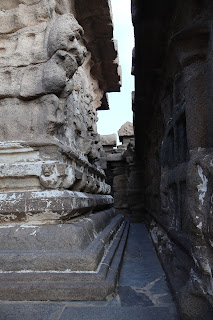The Shore Temple (c. 725 CE) is a complex of three temples and shrines that
overlooks the shore of the Bay of Bengal. It is located in Mahabalipuram,
about 60 kilometres (37 mi) south of Chennai in Tamil Nadu, India.
It is a structural temple, built with blocks of granite, dating from the 8th
century CE. At the time of its creation, the site was a busy port during the
reign of Narasimhavarman II of the Indian Pallava dynasty. It is one of the
oldest structural (versus rock-cut) stone temples of Southern India.
|
Shore Temple history
This structural temple complex was the
culmination of the architectural creations that were initiated by the
King Narasimhavarman II in mid 7th century starting with the Cave
temples and the monolithic Rathas.
-
Even though the architectural creation of sculpturing cut-in and
cut-out structures continued during subsequent periods, as seen in the
Atiranachanda cave, the Pidari rathas and the Tiger cave, the main
credit for the architectural elegance of the Shore Temple complex in
the category of structural temples goes to the King Rajasimha (700–28
CE), also known as Narasimhavarman II, of the Pallava Dynasty.
-
It is now inferred that this temple complex was the last in a series
of temples that seemed to exist in the submerged coastline.
-
The architecture of the Shore Temple was continued by the Cholas (in
the temples that they built) who ruled Tamil Nadu after defeating the
Pallavas.
|
|
Entrance to the Shore Temple
|
|
Shore Temple seen from the Entry
|
|
Shore Temple seen from west
|
|
Shore Temple seen from northwest
|
|
Water tank north of Shore Temple
|
|
Water tank
-
In the center, there is a miniature shrine with the Bhuvaraha image in
a well type enclosure. This is dated to the Pallava King
Narasimhavarman Mamalla's (638–660 CE) reign. It was enclosed with an
elliptical well built during Rajasimha's (700–728 CE) period. These
are carved on the bedrock that also has the reclining Vishnu in the
Shore Temple complex. The miniature shrine is also dedicated to Shiva.
-
Behind the miniature shrine, the carving of the Bhuvaraha depicts
Varaha as the boar incarnation of Vishnu. This image is in unusual
form, unlike another Varaha depictions in other regions of the
country, as there is no Bhudevi shown nor an ocean. The depiction is
in the form of Varaha performing a diving act into the ocean to rescue
Bhudevi or mother earth. The symbolism of this act denotes the myth,
only when the temple is submerged in water, as it is below the ground
level.
|
|
Shore Temple seen from north
All the three Temples of the
Shore Temple complex are built on the same platform.
-
Viewed from the northern end, the temples appear to be a replica of
the Dharmaraja Ratha.
|
|
Shore Temple seen from northeast
The roofs of the temples
have ornamentation similar to the Pancha Rathas.
-
The roofs have finials on the top, indicative of its religious
functional nature, as it was a completed temple.
-
The octagonal shape of the shikaras of the two temples dedicated to
Shiva are in the Dravidian architectural style.
|
|
Shore Temple east side
The main Shore Temple, which faces
east so that the sun rays shine on the main deity of Shiva Linga in the
shrine (bottom photo), is a five-storied structural Hindu temple rather
than rock-cut as are the other monuments at the site.
-
Built with sculpted granite stones hauled from a nearby quarry, it is
the earliest important structural temple in South India.
-
Its pyramidal structure is 18 m (60 ft) high and sits on a 15 m (50
ft) square platform.
|
|
Shore Temple seen from southwest
|
|
Small Shrine
The temple is a combination of three shrines.
The main shrine is dedicated to Shiva, as is the smaller second shrine.
A small third shrine, between the two, is dedicated to a reclining
Vishnu and may have had water channelled into the temple, entering the
Vishnu shrine.
-
The two Shiva shrines are orthogonal in configuration. The entrance is
through a transverse barrel vault gopuram.
-
The two shikharas have a pyramidal outline, each individual tier is
distinct with overhanging eaves that cast dark shadows.
-
The outer wall of the shrine to Vishnu and the inner side of the
boundary wall are extensively sculptured and topped by large
sculptures of Nandi.
-
The temple's outer walls are divided by pilasters into bays, the lower
part being carved into a series of rearing lions.
|
|
Mahishasuramardini Durga lion shrine
A monolith sculpture of
a partly carved and partly sculpted lion with a hole in its torso is
erected within the compound wall of the temple complex.
-
A miniature image of Durga is sculpted on the back of the image, which
is a depiction of Durga as Mahishasuramardini.
-
The open mouth of the lion is inferred as representation of its role
as the favorite lion.
|
|
Space for circumambulation
The temple has a garbhagriha
(sanctum sanctorum) in which the deity, Sivalinga, is enshrined, and a
small mandapa surrounded by a heavy outer wall with little space between
for circumambulation.
|
|
Shore Temple seen from southwest
We can see the smaller
temple on the left side and the larger temple on the right side.
|
|
Shore Temple seen from west
|
|
Shore Temple seen from northwest
We can see the smaller
temple on the right side and the larger temple on the left side.
-
The entire compound wall surrounding the temples is sculpted with
large sculptures of Nandi, the vehicle or mount of Shiva, and also
with Yalis and Varahas (boars).
|
See Also
Source
Location


































